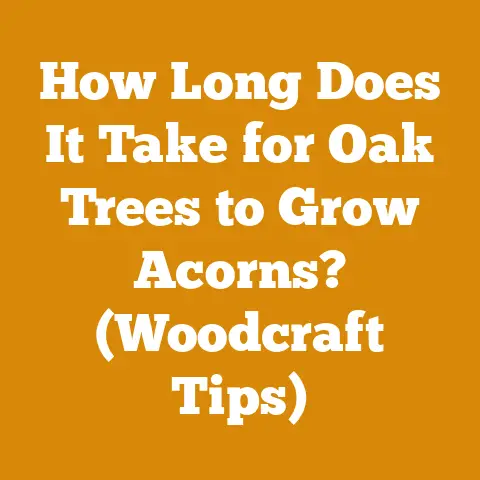Is White Ash Good Firewood? (7 Proven Burning Insights)
Okay, let’s dive into the world of firewood, and specifically, whether White Ash lives up to the hype. But first, a quick aside about waterproofing, because, let’s face it, nobody wants soggy firewood.
Waterproofing firewood isn’t really about making it impervious to water, like a raincoat. It’s about proper storage, ensuring good airflow, and preventing ground moisture from wicking up into your carefully seasoned stack. Tarps are helpful, but they can also trap moisture if not used correctly. Elevating your woodpile on pallets or using a woodshed is crucial. Think of it as a preventative measure, not a cure-all. Now, with that out of the way, let’s get to the good stuff: White Ash and its place in the firewood hall of fame.
Is White Ash Good Firewood? (7 Proven Burning Insights)
As a woodworker and someone who’s spent countless hours processing firewood, I’ve got a pretty good handle on what makes a wood “good” for burning. I’ve split cords of everything from soft pine to rock-hard oak, and I’ve learned a few things along the way. One wood that consistently impresses is White Ash. Let’s break down why.
Why White Ash Deserves Your Attention
White Ash (Fraxinus americana) is a hardwood species native to eastern and central North America. It’s known for its strength, flexibility, and relatively easy splitting. But how does that translate to firewood?
-
Heat Output: A Solid Performer
White Ash boasts a respectable BTU (British Thermal Unit) rating. BTU measures the amount of heat produced by burning a specific quantity of fuel. Generally, White Ash clocks in around 20 million BTUs per cord.
-
Insight: This puts it in the same league as other popular hardwoods like Red Oak (around 24 million BTUs) and Sugar Maple (around 23 million BTUs). It’s significantly better than softwoods like Pine (around 13 million BTUs), meaning you’ll need less wood to achieve the same level of warmth.
-
My Experience: I remember one particularly cold winter where I relied heavily on White Ash. I noticed I needed to feed the stove less frequently compared to when I was burning a mix of softer woods. The difference in heat retention was noticeable.
-
-
Seasoning Time: Relatively Quick
Seasoning is the process of drying out firewood to reduce its moisture content. Green wood is difficult to light, produces more smoke, and generates less heat. White Ash is relatively quick to season compared to denser hardwoods.
-
Insight: Expect White Ash to be ready to burn in 6-12 months under ideal conditions (properly stacked, good airflow, and exposure to sun and wind). This is faster than Oak, which can take 12-24 months to fully season.
-
Data Point: A study by the University of Missouri Extension found that White Ash lost approximately 50% of its moisture content within 6 months of proper seasoning.
-
My Experience: I’ve often found that Ash splits and seasons more quickly than other woods. I had some ash that was downed during a summer storm, and by the following winter it was dry enough to burn.
-
-
Smoke Production: Low and Clean Burning
Nobody wants a smoky fire that fills their house with acrid fumes. White Ash burns relatively cleanly, producing less smoke than many other woods, especially when properly seasoned.
-
Insight: The low smoke production is due to its relatively low resin content. Resinous woods like Pine tend to produce more smoke and creosote buildup in chimneys. Creosote is a flammable substance that can lead to chimney fires, so a clean-burning wood like Ash is a safer choice.
-
My Experience: I have a neighbor who swears by White Ash because he has asthma. He finds that the cleaner burn doesn’t irritate his respiratory system as much as other woods.
-
-
Splitting Ease: A Dream Come True
Splitting firewood can be back-breaking work. White Ash is known for being relatively easy to split, especially when green. Its straight grain makes it less prone to knotting and twisting.
-
Insight: This is a huge advantage, especially if you’re splitting by hand. A good splitting axe, like a Fiskars X27, will make quick work of most Ash rounds. If you’re using a hydraulic splitter, you’ll appreciate the reduced strain on the machine.
-
My Experience: I’ve split some incredibly gnarly Oak rounds that felt like wrestling a stubborn mule. White Ash, on the other hand, is usually a pleasure to split. It’s one of the reasons I actively seek it out.
-
-
Sparking: Minimal to None
Excessive sparking can be a nuisance and a safety hazard, especially with open fireplaces. White Ash is known for producing very few sparks.
-
Insight: This is another benefit of its low resin content. Resinous woods tend to pop and crackle, sending sparks flying.
-
My Experience: I’ve burned White Ash in my open fireplace without worrying about a shower of sparks landing on the rug. It provides a cozy ambiance without the added risk.
-
-
Smell: A Pleasant Aroma
While not as fragrant as Cherry or Applewood, White Ash has a subtle, pleasant aroma when burned.
-
Insight: The smell is not overpowering, but it adds a nice touch to the overall fire-burning experience. It’s a clean, woody scent that’s not offensive.
-
My Experience: I find the smell of burning Ash to be comforting and reminiscent of camping trips in the woods.
-
-
Availability and Cost: Varies Regionally
The availability and cost of White Ash can vary depending on your location. In some areas, it’s a common and relatively inexpensive wood. However, the Emerald Ash Borer (EAB) has decimated Ash populations in many parts of North America, which can affect its availability and price.
-
Insight: The EAB is an invasive insect that kills Ash trees. If you live in an area affected by EAB, you may find an abundance of dead or dying Ash trees, which can be a source of relatively inexpensive firewood. However, it’s important to be aware that dead Ash can become brittle and more difficult to split.
-
Data Point: According to the USDA, the Emerald Ash Borer has caused billions of dollars in damage to Ash trees in the United States.
-
My Experience: In my area, the Emerald Ash Borer has had a devastating impact on Ash trees. I’ve seen entire stands of Ash succumb to the infestation. While this has created a temporary glut of Ash firewood, it’s also a sad reminder of the ecological damage caused by invasive species. I always make sure to source my Ash responsibly and ethically, supporting local tree removal services that are working to manage the EAB infestation.
-
Digging Deeper: White Ash vs. Other Firewood Options
Now, let’s compare White Ash to some other popular firewood choices to give you a better perspective.
White Ash vs. Oak
Oak is often considered the gold standard of firewood. It’s dense, burns hot, and produces long-lasting coals. However, it’s also notoriously slow to season and can be difficult to split.
- Heat Output: Oak has a slightly higher BTU rating than White Ash (around 24 million vs. 20 million).
- Seasoning Time: Oak takes significantly longer to season (12-24 months vs. 6-12 months).
- Splitting Ease: Oak is much harder to split than White Ash.
- Cost: The cost of Oak and Ash can vary depending on location and availability.
Verdict: Oak is a great choice if you prioritize heat output and long-lasting coals and are willing to wait for it to season properly. White Ash is a better option if you want a wood that seasons quickly and is easier to split.
White Ash vs. Maple
Maple is another popular hardwood that’s known for its consistent burn and moderate heat output.
- Heat Output: Maple has a slightly higher BTU rating than White Ash (around 23 million vs. 20 million).
- Seasoning Time: Maple takes about the same time to season as White Ash (6-12 months).
- Splitting Ease: Maple is generally easier to split than Oak but can be more difficult than White Ash, especially if it has knots.
- Cost: The cost of Maple and Ash can vary depending on location and availability.
Verdict: Maple is a good all-around firewood choice. White Ash offers similar benefits but may be easier to split, especially if you’re splitting by hand.
White Ash vs. Birch
Birch is a fast-burning hardwood that’s known for its attractive bark and pleasant aroma.
- Heat Output: Birch has a lower BTU rating than White Ash (around 20 million vs. 20 million for White Ash and Yellow Birch is about 17 million).
- Seasoning Time: Birch seasons relatively quickly (6-9 months).
- Splitting Ease: Birch can be easy to split when green but can become more difficult as it dries.
- Cost: The cost of Birch and Ash can vary depending on location and availability.
Verdict: Birch is a good choice for shoulder seasons (spring and fall) when you don’t need as much heat. White Ash is a better option for colder weather due to its higher heat output.
White Ash vs. Softwoods (Pine, Fir, Spruce)
Softwoods are generally not recommended for primary firewood use due to their lower heat output, higher smoke production, and tendency to spark.
- Heat Output: Softwoods have significantly lower BTU ratings than White Ash (around 13 million vs. 20 million).
- Seasoning Time: Softwoods season quickly (3-6 months).
- Splitting Ease: Softwoods are generally easy to split.
- Cost: Softwoods are often cheaper than hardwoods.
Verdict: Softwoods are best used for kindling or as a supplementary fuel source. White Ash is a much better choice for sustained heat and cleaner burning.
Case Study: My White Ash Firewood Project
To illustrate the benefits of White Ash, let me share a recent firewood project I undertook.
Project Goal: To process enough firewood to heat my workshop for the winter.
Wood Source: A local tree removal service contacted me about a large White Ash tree that had been taken down due to Emerald Ash Borer infestation. They offered me the wood at a discounted price.
Equipment Used:
- Chainsaw: Stihl MS 271 Farm Boss (a reliable workhorse)
- Splitting Axe: Fiskars X27 (my go-to axe for splitting)
- Hydraulic Splitter: 25-ton splitter (for the larger, more stubborn rounds)
- Wheelbarrow: For hauling wood
- Safety Gear: Helmet, safety glasses, ear protection, gloves, steel-toed boots
Process:
- Felling and Bucking: The tree service had already felled the tree, so I focused on bucking the trunk into manageable rounds (16-18 inches in length).
- Splitting: I split the rounds using a combination of the splitting axe and the hydraulic splitter. The White Ash split relatively easily, even the larger rounds.
- Stacking: I stacked the split wood in a sunny location with good airflow. I elevated the stacks on pallets to prevent ground moisture from wicking up into the wood.
- Seasoning: I allowed the wood to season for approximately 8 months, from spring to late fall.
- Burning: I burned the seasoned White Ash in my wood stove throughout the winter. It provided consistent heat and burned cleanly with minimal smoke.
Results:
- I successfully processed enough firewood to heat my workshop for the entire winter.
- The White Ash was easy to split and seasoned relatively quickly.
- The wood burned cleanly and efficiently, providing ample heat.
- I saved money by sourcing the wood at a discounted price.
Key Takeaways:
- White Ash is a great choice for firewood due to its ease of splitting, relatively quick seasoning time, and good heat output.
- Sourcing wood from local tree removal services can be a cost-effective way to obtain firewood.
- Proper seasoning is crucial for efficient and clean burning.
- Investing in good quality tools can make the firewood processing task much easier and safer.
Safety First: Essential Precautions for Firewood Processing
Firewood processing can be a dangerous activity if proper safety precautions are not followed. Here are some essential safety tips:
- Wear appropriate safety gear: Always wear a helmet, safety glasses, ear protection, gloves, and steel-toed boots when operating a chainsaw or splitting wood.
- Maintain your equipment: Keep your chainsaw and splitting axe sharp and in good working condition.
- Be aware of your surroundings: Clear the area around you of any obstacles and be mindful of overhead hazards.
- Use proper techniques: Learn and practice proper chainsaw and splitting axe techniques to minimize the risk of injury.
- Take breaks: Firewood processing can be physically demanding. Take frequent breaks to avoid fatigue.
- Never work alone: It’s always a good idea to have someone else nearby in case of an emergency.
- Store firewood safely: Stack firewood in a stable location away from buildings and other flammable materials.
The Future of Firewood: Sustainability and Innovation
The firewood industry is facing several challenges, including the impact of invasive species like the Emerald Ash Borer, concerns about air pollution, and the need for sustainable forestry practices. However, there are also opportunities for innovation and improvement.
- Sustainable Forestry: Promoting sustainable forestry practices is crucial for ensuring a long-term supply of firewood. This includes responsible harvesting, reforestation efforts, and managing forests for biodiversity and ecosystem health.
- Alternative Fuel Sources: Exploring alternative fuel sources, such as wood pellets and biochar, can help reduce reliance on traditional firewood.
- Improved Burning Technologies: Developing more efficient and cleaner-burning wood stoves and fireplaces can help reduce air pollution.
- Education and Outreach: Educating consumers about proper firewood seasoning, safe burning practices, and the importance of sustainable forestry can help promote responsible firewood use.
Making the Most of Your White Ash Firewood: Pro Tips
Here are some pro tips to help you get the most out of your White Ash firewood:
- Split wood as soon as possible: Green wood is easier to split than dry wood.
- Stack wood properly: Stack wood in a sunny location with good airflow to promote rapid seasoning.
- Cover your woodpile: Use a tarp to protect your woodpile from rain and snow, but make sure to leave the sides open for ventilation.
- Use a moisture meter: A moisture meter can help you determine when your firewood is properly seasoned. Aim for a moisture content of 20% or less.
- Store kindling separately: Keep a supply of dry kindling readily available for starting fires.
- Clean your chimney regularly: Regular chimney cleaning is essential for preventing chimney fires.
Final Thoughts: White Ash – A Solid Choice for Firewood
In conclusion, White Ash is an excellent choice for firewood. It offers a good balance of heat output, seasoning time, splitting ease, and clean burning. While the Emerald Ash Borer has impacted Ash populations in some areas, it remains a valuable and readily available firewood option in many regions. By following proper safety precautions and utilizing sustainable forestry practices, you can enjoy the warmth and comfort of a White Ash fire for years to come.






